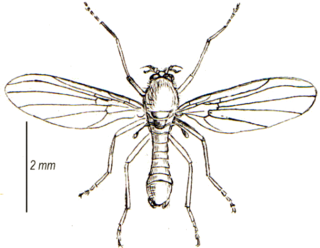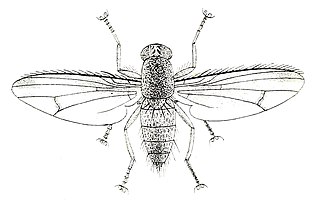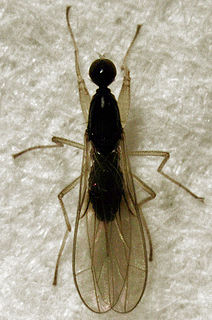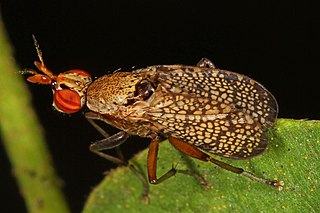
Hoverflies, also called flower flies or syrphid flies, make up the insect family Syrphidae. As their common name suggests, they are often seen hovering or nectaring at flowers; the adults of many species feed mainly on nectar and pollen, while the larvae (maggots) eat a wide range of foods. In some species, the larvae are saprotrophs, eating decaying plant and animal matter in the soil or in ponds and streams. In other species, the larvae are insectivores and prey on aphids, thrips, and other plant-sucking insects.

The family Sciomyzidae belongs to the typical flies (Brachycera) of the order Diptera. They are commonly called marsh flies, and in some cases snail-killing flies due to the food of their larvae.

Pierre-Justin-Marie Macquart was a French entomologist specialising in the study of Diptera. He worked on world species as well as European and described many new species.

The grass flies or cluster flies or attic flies are the genus Pollenia in the family Polleniidae are completely harmless to human health. They are strictly parasitic on earthworms; the females lay their eggs near earthworm burrows, and the larvae then feed on the worms. Cluster flies seek refuge in cold weather and find their way into attic spaces and similar areas indoors. They often emerge on warm days, and cluster at windows attempting to exit.

Thaumaleidae, the solitary midges or trickle midges, are a group of nematoceran flies related to the Ceratopogonidae, Chironomidae, and the Simuliidae. They are small, stocky, yellow to brown flies (3–4 mm). Very few species are known for this family. Larvae are found in films on rocks and the nonfeeding adults are usually found on foliage along the same streams in which the larvae are found. A few solitary midges are found in the Southern Hemisphere, but Thaumaleidae are generally an Holarctic family.

The Curtotonidae or quasimodo flies are a small family of small grey to dark brown humpbacked flies (Diptera) with a worldwide distribution, but with very few species in the Nearctic, Australasian/Oceanian, and Palaearctic regions. Most members of the family are found in tropical to subtropical latitudes in Africa and the Neotropics. Many remain undescribed in collections, since little work on the family has been done since the 1930s.

Canacidae, incorrectly Canaceidae, or beach flies, surf or surge flies, is a family of Diptera. There are 113 species in 12 genera. The family now includes Tethininae as a subfamily.

Trichopezinae are a subfamily of empidoid flies. They are mainly predatory flies like most of their relatives, and generally small to medium-sized, long-legged and large-eyed.
The Canthyloscelidae are a small family of midges closely related to the Scatopsidae.

The Helosciomyzidae are a small family of flies - 9 genera and 22 species. All are known from the Southern Hemisphere. With the exception of the South American genus Sciogriphoneura, the family occurs in Australia, New Zealand. Little is known of their biology.

Hemerodromiinae are a worldwide group of predatory flies with raptorial forelegs.

Brachystomatinae is a subfamily of flies belonging to the family Empididae.

Clinocerinae is a subfamily of flies belonging to the family Empididae.

Empidinae are a subfamily of empidoid flies. They are mainly predatory flies like most of their relatives, and generally small to medium-sized. Most species are flower visitors and they can be effective pollinators.

Hydrophorinae is a subfamily of flies in the family Dolichopodidae. According to Germann et al. (2011), the subfamily is polyphyletic.

Sciapodinae is a subfamily of flies in the family Dolichopodidae.

Diaphorinae is a subfamily of flies in the family Dolichopodidae.

Tetanocerini is a tribe of flies in the family Sciomyzidae. There are at least 120 described species in the tribe.

Sciomyzinae is a subfamily of flies in the family Sciomyzidae.

Sciapodini is a tribe of flies in the family Dolichopodidae.




















